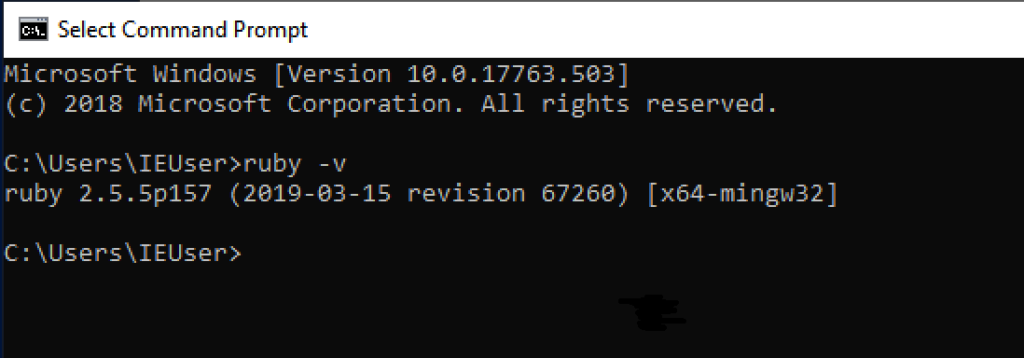(Related article: How to Install Ruby on Rails for Linux (Ubuntu))
Step 1. Upgrade Your System to OS X Mavericks
Ruby is a scripting language designed by Yukihiro Matsumoto, also known as Matz. It runs on a variety of platforms, such as Windows, Mac OS, and the various versions of UNIX. This tutorial gives a complete understanding on Ruby. Installing Ruby on Mac. Installing Ruby on a Mac is a bit different; because OS X is based on Unix, using an installer (a la Windows) isn't the way it's done. First off, Ruby actually comes installed on OS X.
Installing Ruby on Rails is simple, but unless you have an old Mac machine (a pre ‘08 model), you should seriously consider upgrading your system to OS X Mavericks (10.9). It comes with the latest improvements from Apple, and it’s completely free! You can follow this guide for this upgrade.
Step 2. Install XCode Command Line Developer Tools
We need to first install Apple’s XCode Command Line Developer Tools, so that we can use the build tools and utilities that come with it to build Ruby gem native extensions and install other system packages.
This used to be a lengthy process, but if you are on Mavericks, all you have to do is to run this command in your terminal:
After the installation, type
and if the response has something like Apple LLVM version 5.0, you are all set.
Step 3. Install Homebrew
Homebrew is the best package manager on Mac. If you are still using MacPorts, it’s time to start brewing! To install homebrew, use this one line installer:
After it finishes, type

you should see the response as /usr/local/bin/brew
Step 4. Install Ruby with RBENV
Your Mac already ships with Ruby (we used it to install homebrew in the last step). However, it’s still a good idea to use a Ruby version manager because:
- the system Ruby is likely outdated and you may want to use the latest Ruby version to leverage the new features
- you may need to work on multiple projects on different Ruby Versions
RVM and RBENV are the two leading Ruby version managers. I prefer RBENV because it’s a simpler and lighter weight solution, and together with bundler, it solves the project gemset problem in a more elegant way.
We can just use homebrew to install rbenv.
rbenv by itself only manages switching ruby versions. ruby-build and rbenv-gem-rehash are both rbenv plugins. ruby-build allows you to install rubies with rbenv and rbenv-gem-rehash automatically hashes new gems for you when they are installed. You can see here to learn more about rbenv plugins.
You need to initialize rbenv by adding this line in your ~/.bashrc file.
Now you are ready to install Ruby with rbenv. At the time of this writing, the latest stable Ruby version is 2.1.0, so let’s install that.
Step 5. Install Git and Set Up Github Account
Git is the version control system of choice for the Ruby community. If you followed this guide, you should already have git installed as part of the XCode Command Line Developer Tools. You may also want to install git separately with homebrew for easier upgrading.
Now tell git your name and email that it will use for your commits.
Github is the leading platform for source code hosting and collaboration. If you don’t have an account yet, go ahead and sign up for one at https://github.com. Make sure you sign up with the same email address from the step above.
For easier authentication with Github when you push or pull code, follow this guide to set up ssh keys for your Mac.
Step 6. Create a New Rails Application
If you don’t have a directory to hold all your development projects yet, you can create that directory like below:
Now you can create a Rails project in that directory:
Wait until the the last step finishes, and you just created your first Rails project! You can verify that you set up Rails by first starting the server
Now open up your browser and type in the address bar http://localhost:3000 and if you see a welcome page, your app is running locally.
Step 7. Set Up Sublime Text as Code Editor
If you already have an editor of choice, such as Vim or Emacs, you can skip this step. :) If you are not familiar with code editors, Sublime Text is an excellent choice and you can download it here.
Mac Ruby Update
After you install it, run the following command:
and now you can simply type
in your Rails project directory to start coding.
The convention for Ruby programs is to use two spaces as indentation. You can follow Sublime Text 2 => Preferences => Settings - User and add these lines.
Optional Step 1. Use iTerm 2, zsh and oh-my-zsh to set up an awesome terminal
Download and Install iTerm 2. It comes with more features and is easier to customize than the built in Terminal.
Now it’s time to customize your terminal! Here are some of my preferences.
- Under “General”, check “Copy to clipboard on selection”
- Under “Profile” => “Colors”, click on “Load Presets”, then choose “Dark Background”
- Under “Profile” => “Text”, change the font to one that you enjoy looking at. My favorite is 20pt Anonymous Pro with Anti-aliased. You have to download it first and install it into your Mac’s font book before you can use it
- Under “Keys”, define a hotkey to hide/show the terminal window. This is much faster than having to Command+Tab through opened windows and find iTerm 2
Zsh is an alternative shell to the default bash shell that comes with Mac. It adds nice features such as smart tab completions, but what really sets it apart is its scriptability. Together with oh-my-zsh, an open source zsh configuration management framework, it becomes really easy to customize both the look and functionality of your terminal.
Your Mac already comes with zsh. To use zsh, go to iTerm 2 => Preferences => Profiles => General and in the “Command” section, select “Command”, and type /bin/zsh in the box after it. Now close your terminal and relaunch it, you should be on zsh!
Next, let’s install oh-my-zsh:
Now you can customize the ~/.zshrc file.
- If you have your settings in
~/.bash_profile, you may want to copy them over to/.zshrc. - Find the
plugins=(git)line and add more plugins. Here is the plugins I am using:

If you do not like the default theme, you can pick from one of the many themes that come with oh-my-zsh. You can see the list of themes here and here.
If you feel really adventurous, you can even build your own theme! Take a look at how themes are implemented, and copy/tweak/build one exactly to your taste!
Ruby Mac Apples
Optional step 2. Install Postgresql as a production quality database
By default, Rails uses sqlite3 as the default development database. It’s a nice database but probably not one that you want to use in production. Postgresql is a solid, production quality relational database and works well with Rails. It’s generally a good idea to set up your local database to match the database on the production environment.
The easiest way to use Postgresql on Mac is to download and install the Postgres.app
With Postgresql running, add gem 'pg' to the Gemfile in your rails project and run bundle install to install the Postgresql Ruby driver. This RailsCast talks about how to set up with Postgres in detail. You can skip the “taps” part if you don’t already have data that needs to be migrated.

Congratulations!
What Is Ruby For Mac Os
This is it! You just made it to the end of our first rails tutorial, and have now set up your local Ruby on Rails development environment like a pro, now it’s time to start coding. :)

Here you can get the latest Ruby distributions in your favorite flavor.The current stable version is 2.7.2.Please be sure to read Ruby’s License.
Ways of Installing Ruby
We have several tools on each major platform to install Ruby:
- On Linux/UNIX, you can use the package management system of yourdistribution or third-party tools (rbenv and RVM).
- On macOS machines, you can use third-party tools (rbenv and RVM).
- On Windows machines, you can use RubyInstaller.
See the Installation page for details on usingpackage management systems or third-party tools.
Of course, you can also install Ruby from source on all major platforms.

What Is Ruby For Mac Catalina
Compiling Ruby — Source Code
Installing from the source code is a great solution for when you arecomfortable enough with your platform and perhaps need specific settingsfor your environment. It’s also a good solution in the event that thereare no other premade packages for your platform.
See the Installation page for details on buildingRuby from source. If you have an issue compiling Ruby, consider usingone of the third party tools mentioned above. They may help you.
- Stable releases:
- Ruby 2.7.2
sha256: 6e5706d0d4ee4e1e2f883db9d768586b4d06567debea353c796ec45e8321c3d4 - Ruby 2.6.6
sha256: 364b143def360bac1b74eb56ed60b1a0dca6439b00157ae11ff77d5cd2e92291
- Ruby 2.7.2
- Preview releases:
- Ruby 3.0.0-preview1
sha256: ce8bd7534e7ec2a870b24d2145ea20e9bbe5b2d76b7dfa1102dbee5785253105
- Ruby 3.0.0-preview1
- In security maintenance phase (will EOL soon!):
- Ruby 2.5.8
sha256: 6c0bdf07876c69811a9e7dc237c43d40b1cb6369f68e0e17953d7279b524ad9a
- Ruby 2.5.8
- Not maintained anymore (EOL):
- Ruby 2.4.10
sha256: 93d06711795bfb76dbe7e765e82cdff3ddf9d82eff2a1f24dead9bb506eaf2d0 - Ruby 2.3.8
sha256: b5016d61440e939045d4e22979e04708ed6c8e1c52e7edb2553cf40b73c59abf
- Ruby 2.4.10
- Snapshots:
- Stable Snapshot of ruby_2_7 branch:This is a tarball of the latest snapshot of the current
ruby_2_7branch. - Stable Snapshot of ruby_2_6 branch:This is a tarball of the latest snapshot of the current
ruby_2_6branch. - Stable Snapshot of ruby_2_5 branch:This is a tarball of the latest snapshot of the current
ruby_2_5branch. - Nightly Snapshot:This is a tarball of whatever is in Git, made nightly.This may contain bugs or other issues, use at your own risk!
- Stable Snapshot of ruby_2_7 branch:This is a tarball of the latest snapshot of the current
For more information about specific releases, particularly older releasesor previews, see the Releases page.Information about the current maintenance status of the variousRuby branches can be found on the Branches page.
What Is Ruby Gems Mac
For information about the Ruby Subversion and Git repositories, see ourRuby Core page.
The Ruby source is available from a worldwide set ofMirror Sites.Please try to use a mirror that is near you.
